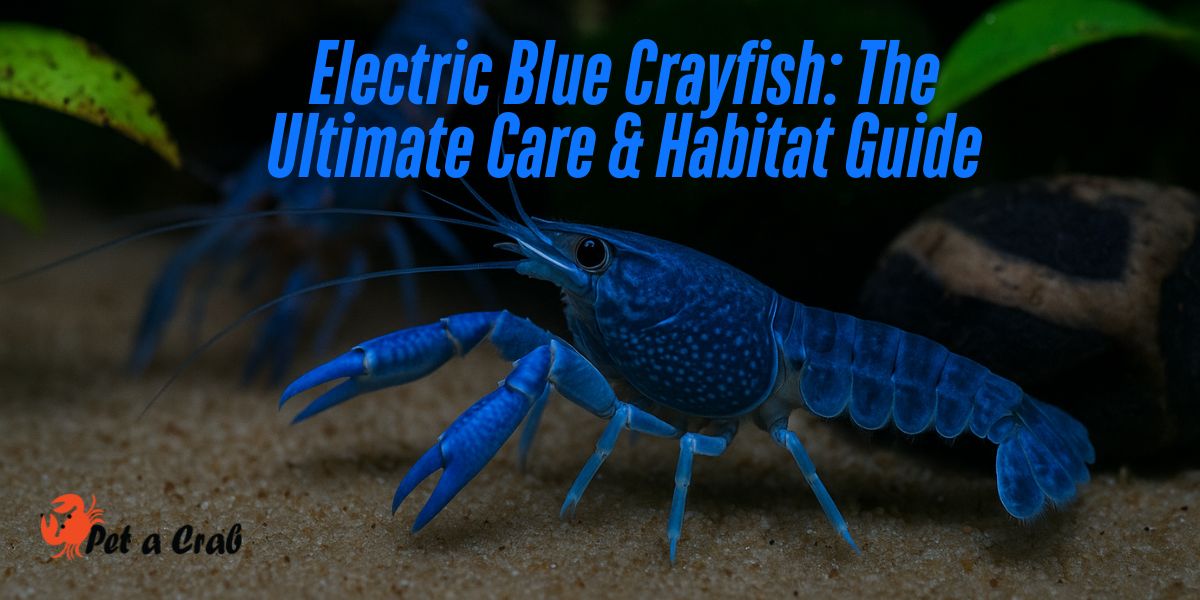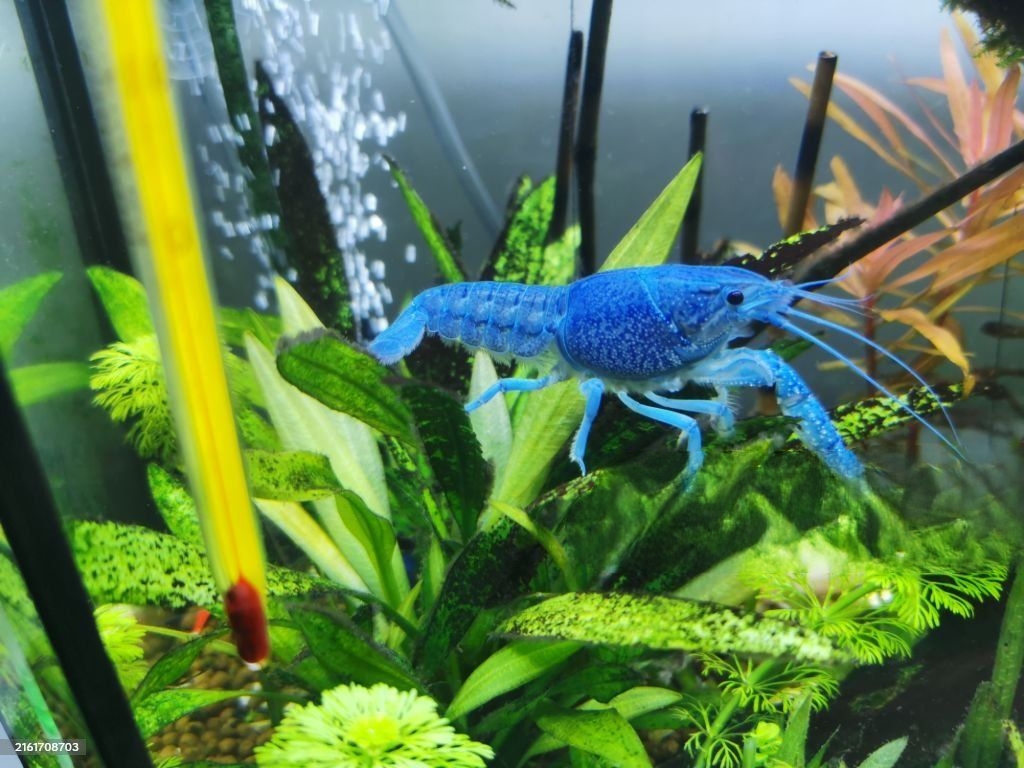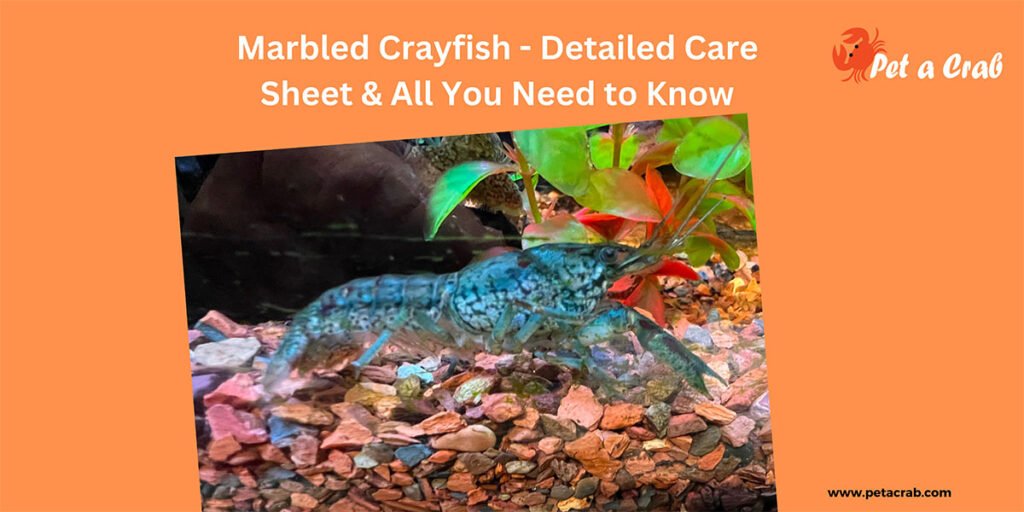A gleaming sapphire of the freshwater world, the Electric Blue Crayfish (Procambarus alleni) is a stunning crustacean prized for its brilliant color and capacity to thrive. Also referred to as the Blue Lobster or Florida Crayfish, this species has long captivated aquarium aquarists worldwide. Although they are robust, they need proper care for long life and optimal health.

In this guide, I will be discussing everything from tank setup, diet, and behavior to breeding and molting. Thus, you have all the knowledge required to keep this amazing species thriving.
Overview of Electric Blue Crayfish
- Scientific Name: Procambarus alleni
- Common Names: Blue crayfish, Electric blue crayfish, Blue lobster, Florida crayfish, Everglades crayfish, Sapphire crayfish
- Size: 4–5 inches (10–12 cm)
- Tank Size: Minimum 20 gallons (90 liters)
- Water Temperature: 71–80°F (22–27°C)
- pH Range: 7.0–8.0 (6.0–9.0 tolerance)
- General Hardness (GH): 6–8
- Diet: Omnivorous, while juveniles tend towards carnivorous, adults towards herbivorous diets
- Temperament: Extremely aggressive
- Care Level: Easy
- Breeding Difficulty: Easy
- Lifespan: 5 years
- Color Variations: Primarily blue, with red, orange, brown, and white
Interesting Electric Blue Crayfish Facts
Natural Habitat
Where Do Electric Blue Crayfish Live?

Electric blue crayfish are native to Florida’s freshwater areas, including marshes, ditches, streams, wetlands, and floodplains. They live in sites with still or slow-moving waters and can also support dry environments by burrowing deep into the ground to maintain their moisture. Additionally, the blue crayfish may be found in brackish waters with a salinity tolerance of as much as 18 parts per thousand.
Behavior
How Do Electric Blue Crayfish Behave in Captivity?
Crayfish electric blue are nocturnal creatures that prefer dark environments, where they will hide and burrow in caves or in hiding places. Due to their territorial nature, they will become aggressive and are not appropriate for a community tank with slow-moving or small fish.
Appearance & Size
What Do Electric Blue Crayfish Look Like, and How Large Do They Grow?
Electric blue crayfish size typically ranges from 4 to 5 inches (10–12 cm) but can be up to 7 inches (18 cm) for certain wild specimens. So, if you wonder, “How big do Electric Blue Crayfish get?” The answer depends on diet, water quality, and overall electric blue crayfish care sheets.
Electric Blue Crayfish Molting
How Does Molting Affect Electric Blue Crayfish?
Molting is a very crucial process whereby crayfish lose their old exoskeleton in order to grow. Electric crayfish molt very frequently in juveniles but less frequently as they reach maturity. Decreased activity and appetite are precursors to a forthcoming molt. After a molt, they will consume their previous exoskeleton to replenish lost nutrients.
Electric Blue Crayfish Breeding
How Do Electric Blue Crayfish Breed in Captivity?
Their breeding is relatively simple. Males turn females over to deposit sperm, and females incubate electric blue crayfish eggs during 20–30 days. Hatchlings are attached for several days before becoming free. Separation prevents cannibalism.
Electric Blue Crayfish Lifespan
How Long Do Electric Blue Crayfish Live?
Blue electric crayfish can live for 5 to 6 years in perfect conditions. In good care, like a well-kept tank, a nutritious diet, and consistent water parameters, they may live longer.
How To Take Care of Electric Blue Crayfish
Electric Blue Crayfish (Procambarus alleni) are vibrant blue freshwater crustaceans that require special care to thrive in captivity. Below is a comprehensive guide on how to care for them:

Electric Blue Crayfish Tank Setup
Electric Blue Crayfish Tank Size & Water Needs
Tank Size
A minimum of 20 gallons (~90 liters) is recommended for one adult blue crayfish. If keeping multiple crayfish, ensure the tank is larger and that the crayfish are the same size and opposite gender to prevent aggression.
Water Parameters
pH Level: Maintain the pH between 7.0 and 8.0 stable.
Temperature: Keep the electric blue crayfish water temperature between 71–80°F (22–27°C).
Hardness: Total hardness (GH) should be 6 to 8, and carbonate hardness (KH) 4 to 6.
Filtration & Oxygenation
Use a good filtration system to maintain the quality of water. Ensure the tank is well-oxygenated, as crayfish will suffocate in poorly oxygenated water. This can be prevented by using an air bubbler or by leaving access to areas above the waterline.
Substrate & Decorations
Substrate
It is important to choose the right substrate for crayfish since they burrow by nature. Sand or fine-gravel substrate would be ideal, as it can be excavated without damaging their delicate exoskeleton. Avoid sharp and rough gravel that will injure them.
Decorations
Providing plenty of hiding spots helps reduce stress and aggression among crayfish. Adding rocks, driftwood, PVC pipes, and caves creates secure shelters where crayfish can retreat and molt safely.
Live plants should generally be avoided, as crayfish tend to uproot or consume them. However, if you prefer a planted tank, consider using hardy plants like Java fern or Anubias, which can tolerate occasional nibbling. Alternatively, plastic or silk plants offer a similar aesthetic without the risk of destruction.
Related Topic: Peacock Mantis Shrimp Care Guide
Electric Blue Crayfish Diet & Feeding
What Do Electric Blue Crayfish Eat?
Due to its omnivorous nature, electric blue crayfish food requires a mix of protein, greens, and calcium to maintain good health and great coloration.
Protein-Rich Diet: To promote their growth as well as satisfy their energy needs, provide shrimp pellets, fish flakes, and live or frozen foods like bloodworms.
Vegetables: Adding vegetable foods to their diet helps counterbalance the nutritional intake. Vegetables that are blanched, such as zucchini, spinach, and carrots, can be consumed. These provide needed vitamins and fiber while fulfilling their natural foraging requirements.
Calcium Supplements: Since crayfish shed their exoskeletons as they grow, calcium is needed for shell development. Crushed eggshells or a cuttlebone should be added to the tank to promote a healthy and strong exoskeleton. This will give them the minerals they require to prevent molting issues and shell deformities.
Feeding Schedule & Best Practices
Blue electric crayfish should be fed every day in proportionate amounts to prevent overfeeding. These crayfish are opportunistic feeders and would search for food, so it’s essential to provide a balanced diet while also keeping the water clean.
To avoid too much waste, remove any remaining food after several hours. Excess food promotes poor water quality, which increases ammonia levels and stresses the crayfish. Following a routine schedule and monitoring their consumption will create a happy and healthy environment.
Electric Blue Crayfish Tank Mates
Are Electric Blue Crayfish Compatible With Other Aquatic Animals?
Due to their aggressive nature, tank mates should be chosen with care. They are best in specific tanks, but should they be housed with other fish, tank mates must be quick swimmers and should be occupying the higher regions of the tank.
How to Tell If an Electric Blue Crayfish Male or Female?
It is difficult to tell whether a crayfish is male or female, but there are some identifying features to look out for. These are the primary differences:
Electric Blue Crayfish Full Size and Body Shape
Male crayfish are larger and slimmer, especially around the belly, than females. Females are more rounded and wider, especially in the tail region, where they carry eggs.
Sexual Dimorphism
The female has smaller, less noticeable claws (chelae), while the male has larger, more powerful claws. The claws are used both as weapons and for attracting a mate.
Pleopods (Abdomen Appendages)
Observing for pleopods (swimmerets) on the abdomen is maybe one of the most effective ways to tell them apart. In males, the first pair of pleopods (closest to the thorax) are modified into a hard structure called a gonopod, which is used to transfer sperm. In females, these pleopods are softer and are used for holding eggs.
Breeding Behavior
Females, when breeding, are often seen with an apparent number of eggs on their pleopods, known as egg sacs. This is a clear indicator of female crayfish.
Note: If you are curious about crustacean pain perception, don’t miss “Do Crabs and Lobsters Feel Pain?”
Where to Find “Electric Blue Crayfish for Sale Near Me”?
When searching for electric blue crayfish for sale in your location, some good sources to consider are:
Local Pet Stores
Some pet stores with aquatic departments stock a selection of freshwater crayfish, but electric blue crayfish may be less readily available. Larger pet store chains or speciality aquatic stores may stock them.
Aquarium Shops and Specialty Retailers
Look for shops that specialize in rare or exotic species. These stores are more likely to carry blue crayfish or can place special orders. They often provide valuable care advice too.
Online Marketplaces
Websites like Aquabid offer listings from sellers. Always check the seller’s reputation and customer feedback to ensure you’re purchasing healthy crayfish.
For a visual overview and additional insights into electric blue crayfish care, you might find the following video helpful: https://youtu.be/7U6_utLjcXw
Conclusion
By going through this guide on electric blue crayfish, you are now set to maintain a healthy aquarium for these beautiful species. With good water parameters, feeding, and habitat creation, they can be a great addition to your aquarium.
Don’t forget to also go through the care sheets of other crayfish species, like Marbled Crayfish and Red Swamp Crayfish.
Frequently Asked Questions
Can Electric Blue Crayfish Live in a Community Tank?
Yes, but with caution. They are territorial and can be aggressive, especially to slow-moving or bottom-dwellers. Keeping electric blue crayfish in community tank with high-swimming fishes in a suitably sized tank that has lots of places to hide will reduce conflicts.
Are Crayfish Good For Aquariums?
Crayfish are able to add personality and intrigue to aquariums but are not for every setup. Crayfish are disruptive and will uproot plants and rearrange decor, and they will devour small fish and invertebrates, so tank design must be carefully planned out.
Are Crayfish Good Pets?
Crayfish make fascinating pets for dedicated aquarists. They are hardy, easy to care for, and have intriguing behaviors. They do require species-specific housing, however, since they are aggressive and territorial and cannot be kept in the typical community tank with more passive fish.
What’s the Difference Between Crayfish and Lobster?
Crayfish are freshwater crustaceans, while lobsters inhabit seawater. Lobsters are bigger and more muscular in build. In addition, crayfish are kept as pets more often, while lobsters are primarily fished for food.
How Long Can Crayfish Be Out of Water?
Depending on the environment, crayfish can survive in the open for many hours or even days. Crayfish breathe through their gills, which must remain moist in order to function. Experiencing prolonged air exposure will result in their death.
How Many Crayfish Are You Able to Keep in a 20-gallon Tank?
There are different numbers for different species, depending on their size and aggression. Smaller species, like dwarf crayfish (Cambarellus spp. ), prefer small groups, while larger species, like Red Swamp Crayfish (Procambarus clarkii), need more room.


